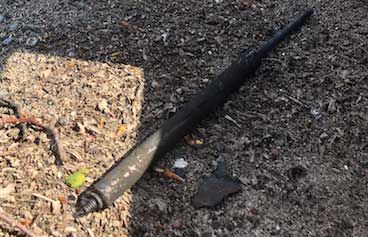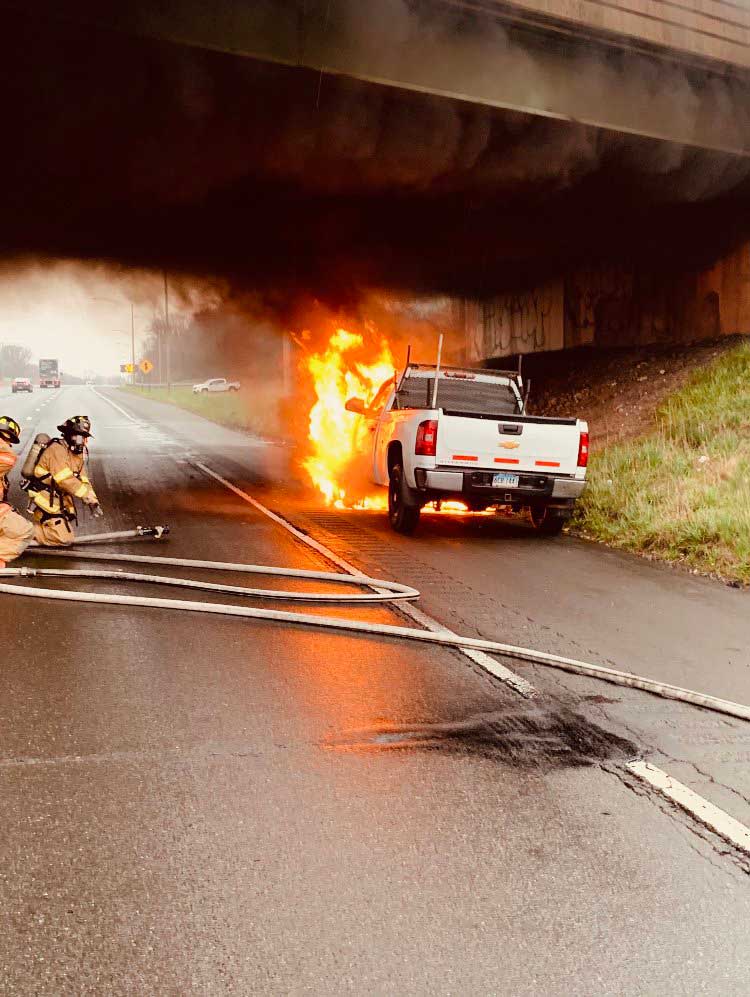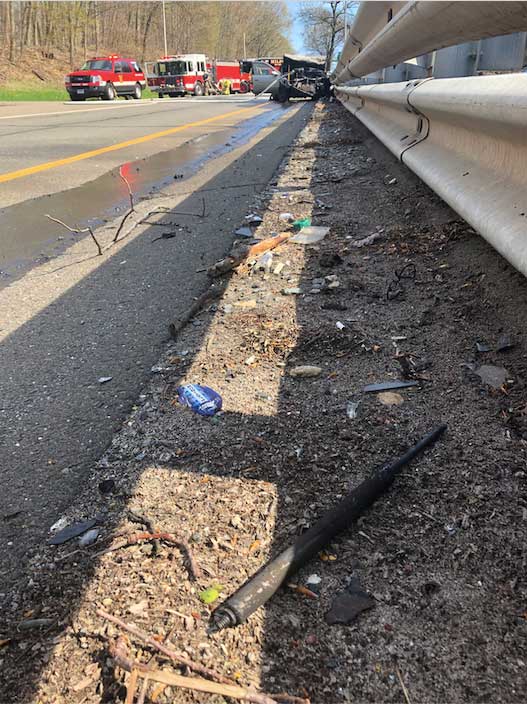All photos curtesy of Ronald Wetmore
When new firefighters begin formal training at an academy, school, or class, the amount of information we receive can seem overwhelming, to say the least. Within a few months, we go from complete novices to participating members of the greatest job on earth. The extensive subject matter we will master is unreal. Within this vast array of material, there are many numerical degrees to memorize:
- When throwing a ground ladder, you must lay the ladder into the building, ensuring a proper working angle of approximately 75 degrees.
- Positive pressure ventilation (PPV) can be improved by tilting the fan/blower 20-30 degrees.
- Hydraulic ventilation is optimized when a nozzle is adjusted between a 30–35-degree fog pattern.

Among the various “degrees” that we must commit to memory, the one most likely to be forgotten may be 45—the angle at which to attack a vehicle fire. If either the front engine compartment or the rear trunk area is involved with fire, proper technique to advance the line is from the corners of the vehicle. Forty-five is not an arbitrary number/angle that was decided upon simply to make the fire attack “look good,” but has significant purpose and logic behind its use.
RELATED FIREFIGHTER TRAINING
- Firefighter Near Miss: Vehicle Fire
- Vehicle Fires: Plastic Fuel Tanks
- It’s NOT Just Another Vehicle Fire!
Over the past 40 years, the automotive industry has made a commitment to ensuring vehicles on the road are as safe as economically feasible. In this time, there has been a monumental shift in the overall design of vehicles. Once rolling up to find a significant crash with victims trapped and in need of extrication has moved to a new reality of arriving to find all occupants out of the vehicle with minor injuries or none whatsoever.
- During the 1980s, improved seat belts were designed and installed, and tougher laws were passed about wearing them.
- In 1999, airbags were required to be supplied in both the driver & passenger side.
- In 2007, Electronic Stability Controls using computer-controlled braking to assist in drivers in maintaining control of their vehicles were introduced.
- In 2009, the roof crush standard was raised to include vehicles weighing 6,000 pounds or less.
- The year 2014 saw the inception of tire pressure monitoring systems (TPMS).

These are just a few of the improvements made to the overall safety of vehicles. When you look at all the advancements together, your father’s car of old is a completely different machine when compared to today’s vehicles on the road.
One technology in this cadre of advancements was the invention and implementation of bumper struts. In the early 1970s, vehicle manufacturers began placing bumper struts—otherwise known as compressed gas struts, gas springs, and vehicle struts—into their vehicles. Always attempting to make vehicles safer, bumper struts were installed to lessen the effects of both front-end and rear-end collisions. The makeup of these struts was quite simple. The strut itself is made from a hollow cylinder. Inside of this hollow cylinder is a smaller solid metal piston. When the strut is in operation, the piston simply slides inside of the hollow cylinder. The strut is filled with gas, most always found in the form of nitrogen (an inert gas). Like some primer pumps found on our fire apparatus, there is a small amount of oil that acts like a seal to the outlet point of where the rod exits the cylinder. When a front end or rear end collision occurs, these bumper struts are in place to absorb the energy from the crash, reducing the potential severity of injury to the occupants.
The concept of these struts is extremely basic and cost effective and can reduce the extent of injury to any victim or passenger. This all sounds extremely similar in function to something we are all aware of, namely truss construction. Truss construction is affordable, easy to install, and in the end very strong under live loads, dead loads, wind, snow, etc. It isn’t until trusses are exposed to fire that they can experience catastrophic failure. As with trusses exposed to heat and fire, these unsuspecting bumper struts, which serve as a safety measure in vehicles, can turn a positive feature into a tragic event in the matter of seconds.

In our formal fire service training, we learn diverse concepts, principles, tactics, and warnings. They all sound great in a lecture or during practical evolutions, but many aren’t truly appreciated or understood until one experiences them on the fireground. About three years ago, my engine company was called to the I95/Route 15 Feeder for a report of a car fire. On arrival, we were presented with nothing new—an engine compartment fire extending into the passenger compartment. After positioning the apparatus, stretching a Mattydale, and starting to put water on the fire, a loud pop occurred, followed by a “metal clang” and several other ever-diminishing clangs. It wasn’t the sound of the popping of tires as at your typical vehicle fire. After extinguishment and a little bit of overhaul, my battalion chief and I walked up the center median to find a bumper strut. The fire had heated up the nitrogen gas inside of the strut, expanding the gas to the point of causing the container itself to explode. After the bumper strut exploded, it proceeded to strike the guardrail then skip down the highway, finally coming to a rest approximately 100-150 feet away. After hearing the intensity of the pop, the clanging of metal as it skipped down the highway, and witnessing its resting place so far from the vehicle, the warning I had learned in class so many years ago began to really sink in.

Throughout the automobile industry’s continuous endeavor to make vehicles safer, bumper struts have gradually been replaced with newer impact-absorbing technologies for front- or rear-end collisions. Although mostly found in older vehicles, bumper struts exist, are still on the road, and can cause critical injury or death to our members operating at vehicle fires.
The principles learned in our fire service training have meaning behind them. Whether it’s raising a ground ladder, venting out a room, or simply attacking a vehicle fire, these concepts are not arbitrary. We must remember that sometimes these seeming simple practices, such as attacking a vehicle fire from a 45-degree angle, are time tested, have purpose, and are meant to protect the overall health and safety of firefighters.

ADAM J. HANSEN is a lieutenant assigned to Engine 7 in the Milford (CT) Fire Department, where he has worked since 2006. He began his career as a volunteer in Branford, Connecticut, in 1999. Hansen has a bachelor’s degree in fire science (fire administration) and a minor in criminal justice from the University of New Haven. He is a nationally registered paramedic and is a state-certified fire service instructor 2, fire officer 2, incident safety officer, pump operator, and aerial operator. He is certified in rescue operations: trench.

